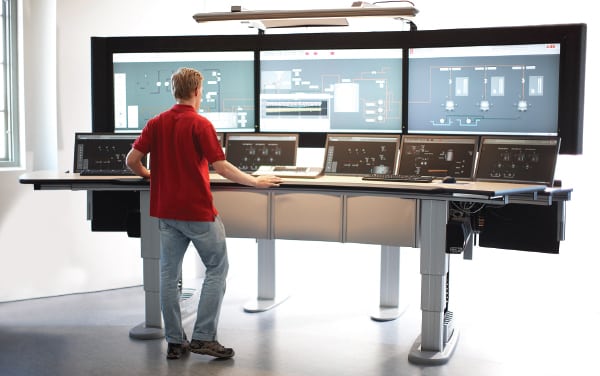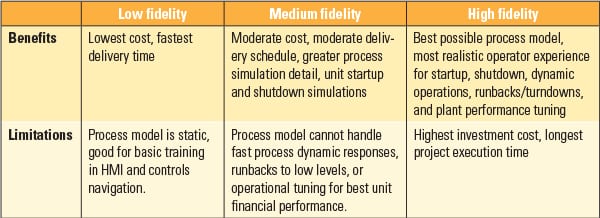Power Plant Training Simulators Explained
Faced with the necessity of doing more with less—and less-experienced—staff, the power business increasingly is turning to simulators for reliable and efficient real-world training.
Training simulators are worth their weight in gold to the power industry, as well as to most process industries in general. People tend to learn the fastest and the most thoroughly when hands-on trial and error is part of their training process. Operational errors made while engaged in training simulations are cost-free and provide high-return lesson events. Conversely, the results of operator errors made during actual plant operations can range from inefficient to catastrophic. Simulators can reduce the time for training an operator from years to months, and achieve it with far better thoroughness and retention. With a built-in ability to review, vary, and repeat operational scenarios until they are cemented in the minds of operators and operators-to-be, no power plant should be without one.
Simulators come in many varieties, where complexity and efficacy are exchanged for cost (Figure 1). Simulators distinguish between emulation and virtual simulation. Emulators do not physically contain the same control system elements or HMIs that the actual process controls contain but merely mimic them with software. A virtual simulator contains exactly the same process controls and HMIs that an operator will encounter in the real process control room, and only the physical processes themselves are simulated by computer. The better the physical system process simulation, the more realistic the virtual simulator becomes, until using it is almost indistinguishable from the real plant control room experience.
 |
| 1. Many options. A variety of simulator options are available. The best (and most expensive) can exactly duplicate real plant processes and operations. Courtesy: ABB |
The complexity and accuracy of this physical process simulation is characterized by what is called the “fidelity” of the simulator. Simulator fidelity is usually described as being low, medium, or high (Table 1). The best, most process-realistic simulators are high fidelity, and as one might expect, they are also the most expensive. Cost notwithstanding, many users choose high-fidelity simulators to train operators so that the trainees get as deeply exposed to the plant as possible, without actually touching it.
 |
| Table 1. Benefits and limitations of simulators vs. fidelity type. Courtesy: ABB |
Simulators as a Critical Training Tool
What are some of the benefits to having a training simulator? Obviously, training is faster and more effective, but this can provide benefits across all plant operations.
For example, new operators can fill vacancies in the existing operator force more quickly. This helps reduce the impact of workforce turnovers and attrition. When new equipment is installed, a simulator is the fastest method of getting existing operators familiar with new procedures. For new plants, simulators can give operators early hands-on “experience,” especially with turnkey projects. Simulators can also be used to let operators practice standard operations. This means faster and more reliable startups, shutdowns, and runbacks. Standardization of operating practices through the use of simulators means that operators who are identified as those with “best practices” can train other staff members in their methods.
And of course, simulators are ideal for safely training operators to respond to abnormal plant conditions. This means improved operational flexibility and response times to widely varying dispatch signals, a reduction in abnormal operating situations, and a reduction of unplanned outages due to operator errors and unforeseen equipment trips.
Financial Returns from Simulator Investments
Low-fidelity simulators are low six-figure investments, while a medium-fidelity simulator will be in the mid six figures. A full high-fidelity simulator will typically be in very low seven-figure territory. From date of order to delivery date, the typical simulator project tends to run about three to six months.
With even the basic benefits discussed above, such as faster startups and reduced outages, simulator projects are amongst the easiest to justify. If a plant has had any significant “operator error” events in its recent history, eliminating these events can bring immediate returns.
Best Practices for Incorporating Simulators
The following are suggested approaches for getting the most value from a simulator investment:
Use the simulator to familiarize trainees with plant systems, functions, and interactions, as well as familiarization with HMIs and process data views.
Use the simulator as a cross-training tool for members of the plant engineering, technical,and maintenance staffs.
Use the simulator as a key element of new operator training:
■ Unit startup, shutdown, and steady state operations
■ Normal responses to small or moderate changes in demand
■ Unit runbacks and turndowns to lowest stable levels of operation
■ Boiler efficiency and safety management under normal conditions
■ Scheduling of routine intermittent operations such as soot-blowing
Use the simulator as the central element for refresher or “continuing education” training for existing experienced operators:
- Shift-to-shift transfer of best setup and control strategy practices
- Shift-to-shift transfer of abnormal situation responses
- Advanced efficiency improvement topics
- Retraining due to unit equipment modifications/additions
Focus on abnormal situational control, with accident prevention and remediation:
- Large tube leaks
- Loss of large pump function
- Loss of fan function
- Loss of feedwater heater(s)
- Loss of burner fuel flow (mill plugging, etc.)
- Boiler pressure control malfunction
- Loss of automatic O2 control
- Loss of critical measurements
- Boiler trip management
- Fuel variability management
- Alarm flooding scenarios
- Use the simulator with plant technical staff, or consulting suppliers, to assist with:
- Review of existing control logic and process responses
- Replays of plant problem scenarios to improve controls and responses
- New control logic testing and debugging
- Design and test of one-button startup/shutdown controls
- Alarm management studies and corrective actions
- Cross-training between specialists of different disciplines
Experiences on the simulator, when combined with actual physical walkdowns, are the fastest way to introduce a new hire or transferee to the characteristics of a unit. The practices outlined above will keep operations staff at the best readiness to handle abnormal situations when they occur. This is born out by the experiences of simulator users not only in fossil and nuclear power, but in all industries that must control large, complex equipment, right up to airline pilots and astronauts. Investments in training simulators continue to grow, and they continue to provide ever-greater possibilities to improve plant safety, reliability, and profitable operation. ■
— Richard W. Vesel is global product manager for power generation energy efficiency with ABB Power Generation, North America.